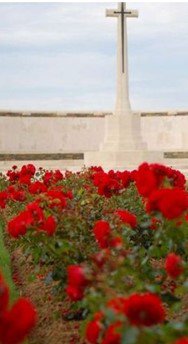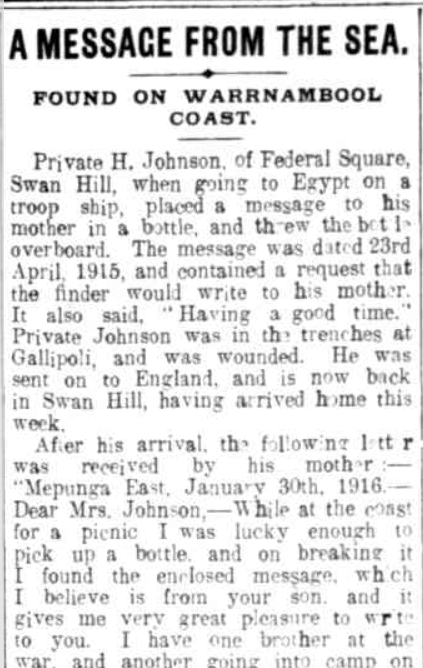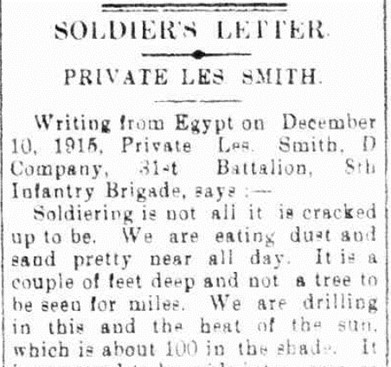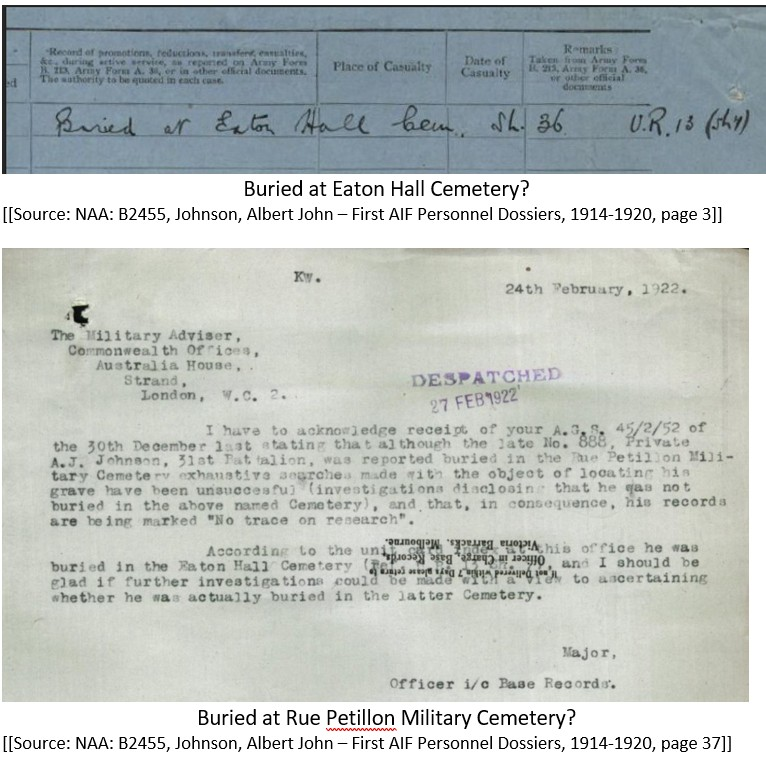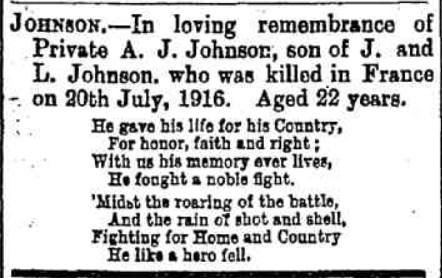Albert John JOHNSON
Eyes grey, Hair light brown, Complexion fair
Albert Johnson - “He wrote to me on the 18th and was killed two days later.”
Can you help us identify Albert?
Albert was killed in Action at Fromelles. As part of the 31st Battalion he was positioned near where the Germans collected soldiers who were later buried at Pheasant Wood. There is a chance he might be identified, but we need help.
In 2008 a mass grave was found at Fromelles, a grave the Germans dug for 250 (Australian) bodies they recovered after the battle. As of 2024, 180 of these soldiers have been able to be identified via DNA testing. We are still searching for suitable family DNA donors for Albert.
If you know anything of contacts for Albert here in Australia or Sweden, please contact the Fromelles Association.
See the DNA box at the end of the story for what we do know about his family.
Early Life
Albert John Johnson was born in 1894 in Swan Hill, Victoria to John and Lousia Mary (nee Brown) Johnson. They had nine children, all born in Swan Hill:
- Amanda Louise 1891-1896
- Percy Charles 1892-1893
- Albert John 1894-1916
- Auliffe Henry (Harry) William 1896 - 1966
- Freda Camelia 1897- unknown
- Louis Andrew 1900- unknown
- Herman Alexander 1902-1971
- Adelaide Lilian twin 1904-1978
- Vera May twin 1904-1967
Albert’s father John Johnson was born Johan Johansson in about 1854 in Stockholm, Sweden to Andrew Johansson and Alisia Andersson. Based on ships’ crew records, he may have come to Australia in the 1880s. His mother was born at Barnadown, near Bendigo, in 1864. They married on 26 September 1890 in Bendigo and moved to Swan Hill, living in the Federal Square area on what is now known as Naretha Street. Albert attended the State School in Swan Hill.
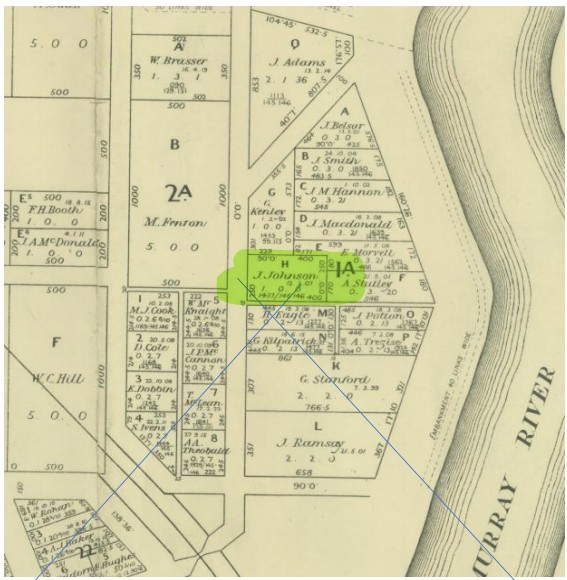
John became a Master Carpenter at Federal Square and Albert completed his apprenticeship here. Brother Harry became a saddler - both very good trades in those days.
Off to War
Albert’s younger brother Harry was the first to enlist (1963), joining on 16 January 1915. He was assigned to the 14th Battalion and with only a limited amount of military training, he left Melbourne to join the forces being assembled for the assault at Gallipoli. Harry was shot in his thigh side during the landing and he had to be transported to England for treatment.
He returned to Australia just shortly after Albert sailed for Egypt. Albert enlisted on 14 July 1915 and was assigned to the newly formed 31st Battalion, which was to be made up of two companies from Victoria and two from Queensland. Albert was assigned to D Company.
The farewells at Swan Hill railway station for potential soldiers would have been an emotional time. The steam train went through Bendigo to Melbourne to take the new soldiers to the training camp at Flemington Depot. No doubt more potential recruits joined the train and farewells happened at all the stations along the way. The full battalion was assembled in early October at the Broadmeadows camp.
Before sailing from Melbourne on 9 November aboard the troopship Wandilla, the 991 soldiers of the 31st had been on parade in Melbourne in front of a good crowd. The Minister for Defence, H.F. Pearce said:
“I do not think I have ever seen a finer body of men.”
Just out of sight of their homeland, several Ballarat boys partook of what was rapidly becoming a tradition of departing troops - they wrote a note, placed it in a bottle and threw it into the ocean, perhaps inspired by stories like Harrys efforts on the way to Gallipoli:
”…Will the finder of this card kindly forward same to "The Ballarat Courier," Ballarat, Victoria.
Appended are the names of some Ballarat boys in D Coy, 31st Battalion, 8th Brigade, and the boat is just leaving Fremantle now en route for the front. A. Wilson, J. Allisey, C. C. Coutts, H. E. Brittain, C. Greenaway, F. A. Collins, W. Hicks, J. Lyons, J. P. Garvey, C. W. Tucker, F. Rawlings, Bert Wallace, H. A. Collins, and H. Phillips. All the above are in good nick for Turks or any others…”
Evander McMillan of Beaconsfield, Western Australia discovered this message, written on a YMCA postcard and inserted into a ‘French glass fruit bottle,’ at Robb's Jetty. He complied with the request and forwarded the card to the newspaper. The Wandilla docked at Port Suez exactly four weeks after leaving Melbourne.
The 31st then went to Serapeum to continue their training and to guard the Suez Canal from any potential threats posed by the Ottoman Army. Near the end of February they moved to the large camp at Tel-el-Kebir , which was about 110 km northeast of Cairo. The 40,000 men in the camp were comprised of Gallipoli veterans and the thousands of reinforcements arriving regularly from Australia. The 60 km trip must have been unpleasant, as it was reported that they were moved in “dirty horse trucks.”
Source - AWM4 23/48/7, 31st Battalion War Diaries, Feb 1916, page 5
The next move came at the end of March 1916, when the 31st Battalion returned to the Suez Canal area, first to Ferry Post and Duntroon Camps, and then finally settling at Moascar by the end of May. During this period, Private Albert Johnson wrote regularly to his mother in Swan Hill, offering detailed and personal insights into both the daily realities of military service and his fleeting moments of reprieve. He described the strict routines and expectations of the day, even while travelling for leave.
“It was our section's turn to leave for Cairo, so we dressed in our Sunday best, as our orderly officer expected us to do. After the inspection we walked to the station at Tel-el-Kebir… The trip was most enjoyable.”
While the day unfolded with sightseeing, the burden of the heat was clear:
“The smell inside the Pyramid was unbearable, and the atmosphere was extremely hot… Before entering we had to take off our boots and tunics on account of the heat.”
These letters reveal how closely the soldiers’ lives were regulated, even when off duty. The days in Egypt blurred between training, exploration, and the slow erosion of patience. As time wore on, the desert heat, repetitive routines, and longing for action took their toll. Private Les Smith (934) later summed up the mood in a letter home.
On 15 June, the 31st Battalion began to make their way to the Western Front, first by train from Moascar to Alexandria and then sailing to Marseilles. A, B and D companies were aboard the troopship Hororata and C company aboard the Manitou. After disembarking on 23 June, they were immediately boarded onto trains to Steenbeque and then marched to their camp at Morbecque, 35 km from Fleurbaix in northern France, arriving on 26 June. The battalion strength was 1019 soldiers.
Fromelles
The area near Fleurbaix was known as the “Nursery Sector” – a supposedly relatively quiet area where inexperienced Allied troops could learn the harsh realities of Western Front trench warfare against the Germans. But the quiet times and the training period did not last long. Training continued, now with how to handle poisonous gas included in their regimen. They began their move towards Fromelles on 8 July and by 11 July they were into the trenches for the first time, in relief of the 15th Battalion.
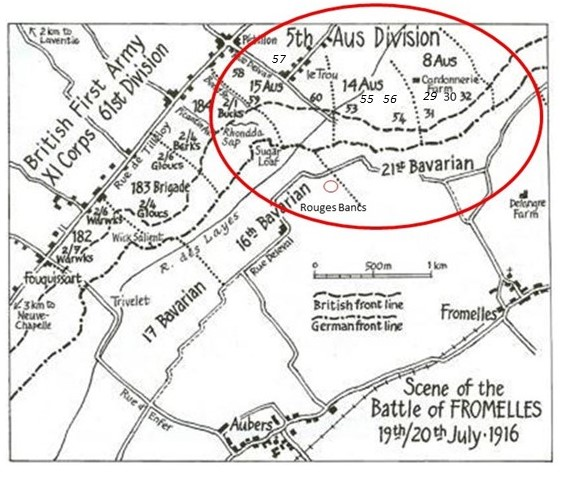
The overall plan was to use brigades from the Australian Fifth Division to conduct a diversionary assault on the German trenches at Fromelles. The main attack was planned for the 17th, but bad weather caused it to be postponed. On the 19th they were back into the trenches and in position at 4.00 PM.
The Zero Hour for advancing from their front-line trenches was to be 5.45 PM, but the Germans knew this attack was coming and were well-prepared. “Just prior to launching the attack, the enemy bombardment was hellish, and it seemed as if they knew accurately the time set.”’
Source: AWM4 23/48/12, 31st Battalion War Diaries, July 1916, page 23
The assault began at 5.58 PM and they went forward in four waves, A and C Company in the first two waves and B and Albert’s D Company in the 3rd and 4th waves. There were machine gun emplacements to their left and directly ahead at Delrangre Farm and there was heavy artillery fire in No-Man’s-Land. The pre battle bombardment did have a big impact and by 6.30 PM the Aussies were in control of the German’s 1st line system (Trench B in the diagram below), which was described as “practically a ditch with from 1 to 2 feet of mud and slush at the bottom.”
Source - AWM4 23/49/12, 32nd Battalion War Diaries, July 1916, page 11

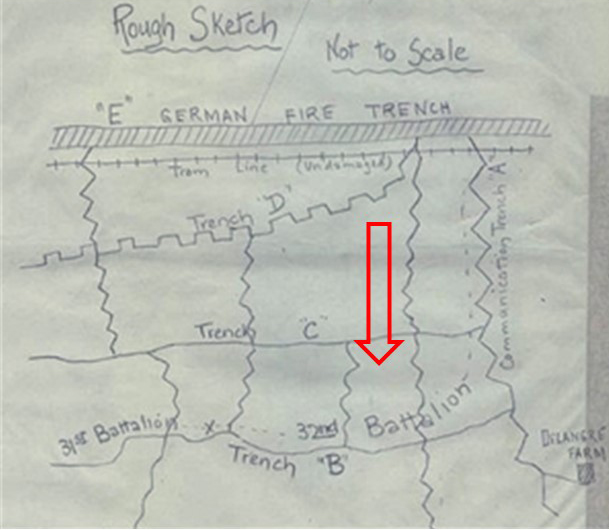
Unfortunately, with the success of their attack, ‘friendly’ artillery fire caused a large number of casualties. By 8.30 PM the Australians’ left flank had come under heavy bombardment with high explosives and shrapnel. Return bombardment support was provided and the 32nd, who also had the job of holding the flank to the left of the 31st, were told that “the trenches were to be held at all costs”.
Source - AWM4 23/49/12, 32nd Battalion War Diaries, July 1916, page 12
Fighting continued through the night. The Australians made a further charge at the main German line beyond Trench B, but they were low on grenades, there was machine-gun fire from behind from the emplacement at Delangre Farm and they were so far advanced that they were getting shelled by both sides. At 4.00 AM the Germans began an attack from the Australian’s left flank, bombing and advancing into Trench A (map).
Given the Australian advances that had been made earlier, portions of the rear Trench E had been left almost empty, which then enabled the Germans to be in a position to surround the soldiers. At 5.30 AM the Germans attacked from both flanks in force and with bombing parties. Having only a few grenades left themselves, the only resistance the 31st could offer was with rifles.
“The enemy swarmed in and the retirement across No Mans' Land resembled a shambles, the enemy artillery and machine guns doing deadly damage.”’
The 31st were out of the trenches by the end of the day on the 20th. From the 1019 soldiers who left Egypt, the initial impact was assessed as 77 soldiers were killed or died from wounds, 414 were wounded and 85 were missing, including Albert. To get some perspective of the battle, when Charles Bean, Australia’s official war historian, attended the battlefield two and half years later, he observed a large quantity of bones, torn uniforms and Australian kit still on the battlefield.
The ultimate total was that 162 soldiers were either killed or died from wounds and of this total 82 were missing/unidentified. The bravery of the soldiers of the 31st was well recognised by their own Battalion commanders.
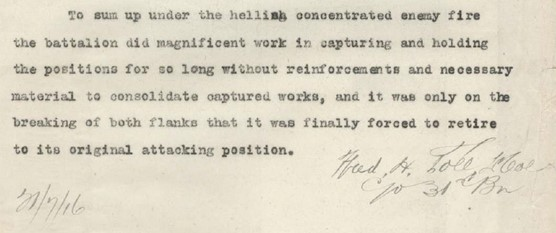
A Family Anxious for Answers
There are no details about exactly what happened to Albert. He was initially reported as wounded and the family were quickly notified. With his parents already having been through this with Harry, it must have been a very trying time. His mother quickly wrote to the Army seeking information about Albert so that she could write to him. Louisa’s last letter from Albert had been dated 18 July.
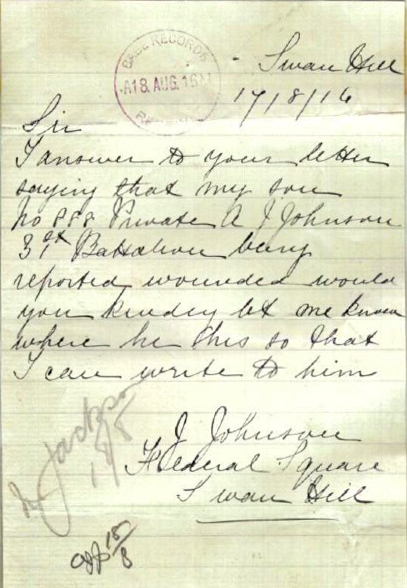
She also received a relatively positive telegram from the Army advising that while they had no details, but “the above soldier is not reported as seriously wounded, and in the absence of further reports favourable progress may be assumed.”
Source - NAA B2455, Johnson, Albert Johnson – First AIF Personnel Dossiers, 1914-1920, page 31
Nine days later Albert was declared as having been killed in action. Louisa then wrote to the Army again, hoping that there had been a mistake made, knowing that inaccurate reports after a battle were not uncommon.
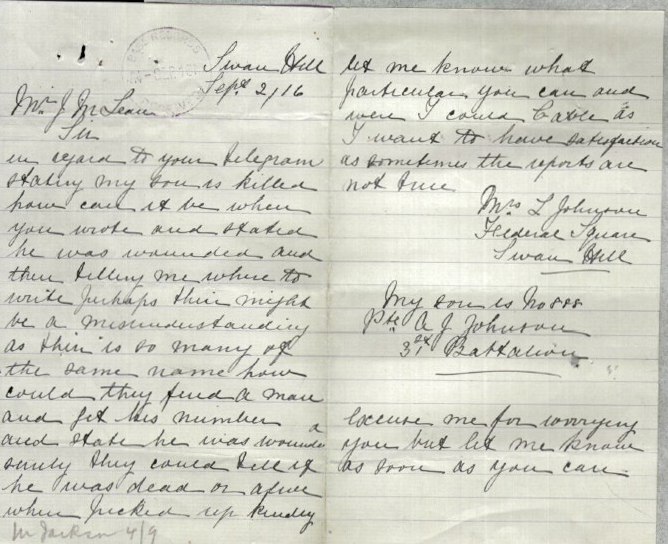
While it did become clear Albert had been killed, there was also confusion about whether he was buried or not, or where.
Eaton Hall was the dressing station adjacent to Rue Petillon, behind the Australian front lines. ”Many of those laid to rest here had died of wounds in a dressing station that was located in the buildings adjoining the cemetery, which were known as ‘Eaton Hall’ during the war.”
Source - https://www.ww1cemeteries.com/rue-petillon-military-cemetery.html
Albert’s mother continued her correspondence with the Army during 1916 and 1917 to get answers about his fate and then to have Albert’s personal effects sent to her, which finally arrived on 29 June 1917.

Small though these returned items are, they must have given deep comfort to the family, especially the letters. Albert’s body has never been found, but then…who recovered his Identity Disc?
He was awarded the 1914-15 Star Medal, the British War Medal, the Victory Medal, a Memorial Plaque and a Memorial Scroll and is commemorated at V.C. Corner Australian Cemetery Memorial Fromelles, France and the Swan Hill WW1 Memorial.
Alfred William Fitch Ansell, another Swan Hill local killed in action at Fromelles, was identified at Pheasant Wood Cemetery in 2024.
Could Albert Still Be Found?
After the battle, the Germans collected 250 soldiers who were later buried at Pheasant Wood. The 31st was fighting in the vicinity of the grave site and, as of 2024, 23 of the 82 unidentified soldiers from the 31st have been able to be identified by DNA matching from family members. They have been formally recognized in the Pheasant Wood Cemetery.
A total of 180 soldiers have been identified. Albert could be one of the remaining 70 unidentified soldiers from the grave, but we are still searching for suitable family DNA donors.
If you know anything of Albert’s contacts here in Australia or his relatives from Sweden, please contact the Fromelles Association.
DNA samples are being sought for family connections to
| Soldier | Albert John Johnson (1894 – 1916) |
| Parents | John Johnson born Johan Johansson, Stockholm, Sweden (1854-1922) and Louisa Mary Brown (1864-1942) Swan Hill |
| Siblings | Amanda Louise (1891-1896) b/d Swan Hill | ||
| Percy Charles (1892-1893), b/d Swan Hill | |||
| Auliffe Henry William (1896 - 1966 ) b Swan Hill, d Benalla VIC, m Annie Goodwin | |||
| Freda Camelia (1897 - unknown) | |||
| Louis Andrew (1900 – 1926), b/d Swan Hill (called Louis Alexander On death record) | |||
| Herman Alexander (1902-1971) b Swan Hill, d Coburg VIC, m Myrtle Victoria May Miles | |||
| Adelaide Lilian (twin) (1904-1978) b Swan Hill, d Preston VIC, m William Goodwin | |||
| Vera May (twin) (1904-1967) b Swan Hill, d Fitzroy VIC, m William Henry Foster |
| Grandparents | |||
| Paternal | Andrew Johansson – Sweden and Alysia Andersson - Sweden | ||
| Maternal | Charles Brown |
Seeking DNA Donors

Contacts
(Contact: carla@fromelles.info or geoffrey@fromelles.info).
(Contact: army.uwc@defence.gov.au or phone 1800 019 090).
Donations
If you are able, please contribute to the upkeep of this resource.
(Contact: bill@fromelles.info ).
